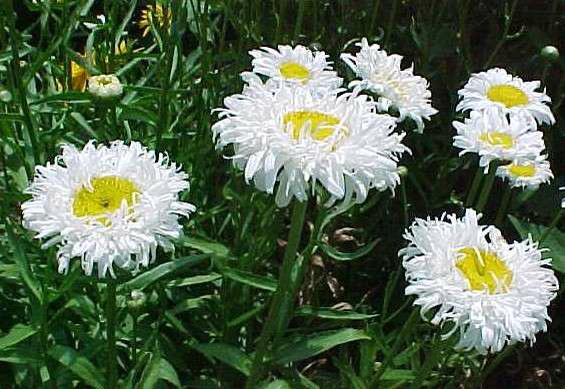Shasta Daisy (Leucanthemum × Superbum ‘Crazy Daisy’)
Shasta Daisy
Leucanthemum × superbum, commonly called Shasta daisy, is a hybrid developed by Luther Burbank (1849-192- in the 1890s near snow covered Mt. Shasta in northern California. Burbank crossed L. vulgare (European oxeye daisy), L. maximum (Pyrenees chrysanthemum), L. lacustre (Portuguese field daisy) and Nipponanthemum nipponicum (Japanese field daisy) to produce Leucanthemum × superbum which was given the common name of Shasta daisy. This hybrid typically grows to 2-3′ tall with a spread to 18″ wide.
Leucanthemums were formerly included in the genus Chrysanthemum.
Genus name comes from the Greek leukos meaning white and anthemum meaning flower in reference to the white flowers of some species.
The hybrid name superbum means superb.
‘Crazy Daisy’ is a Shasta daisy cultivar that typically grows 2-5’ tall. It is noted for its large double blooms (5” diameter) with frilly, twisted white rays and yellow center disks. Multiple flowers per stem. Coarsely-toothed, lance-shaped, medium green leaves (basal leaves to 12” long). Blooms most of the summer. Excellent and long-lasting fresh cut flower.

Easily grown in average, dry to medium, well-drained soils in full sun. Good soil drainage is essential. Wet soils in winter can be fatal. Tolerates some light shade, particularly in hot summer climates or when plants are being grown in dryish soils. Remove spent flower heads to promote additional bloom. Divide clumps as needed (every 2-3 years) to maintain vigor. Plants are somewhat short-lived. Consider cutting stems back to basal leaves after flowering to preserve plant energies and perhaps prolong plant life.
‘Crazy Daisy’ is a seed strain.
| Hardiness zone | 4 - 9 |
| Sun light | Full Sun |
| Water | Dry To Medium |
| Maintenance | Low |
Leucanthemums generally have some susceptibility to verticillium wilt, leaf spots and stem rots. Aphids, leaf miners and mites are occasional visitors.
Shasta daisies provide long-lasting summer bloom and are mainstays of the perennial border, cottage garden and cutting garden. Rock gardens. Containers.
| Common name | Shasta Daisy |
| Botanical name | Leucanthemum × Superbum 'Crazy Daisy' |
| Plant type | Herbaceous Perennial |
| Family | Asteraceae |
| Hardiness zone | 4 - 9 |
| Water | Dry To Medium |
| Maintenance | Low |
| Flower color | Twisted White Rays With Yellow Center |
| Flowering period | June - August |
| Height | 2 - 2.50 Feet |
| Width | 1.50 To 2 Ft. |